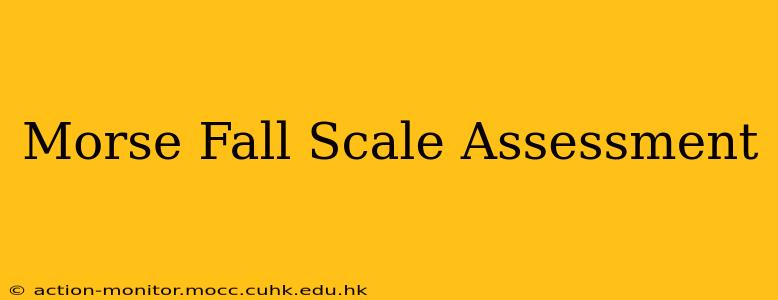The Morse Fall Scale (MFS) is a widely used tool for assessing a patient's risk of falling. Developed by Mary Morse, RN, and colleagues, it's a simple yet effective instrument that helps healthcare professionals identify individuals who may require extra precautions to prevent falls. This guide provides a comprehensive overview of the MFS, its application, and its limitations.
Understanding the Morse Fall Scale
The MFS is a six-item scale that assigns points to various risk factors associated with falls. Each item is scored based on the patient's condition, resulting in a total score that categorizes the patient's fall risk level. Higher scores indicate a greater risk of falling. The scoring system is straightforward, making it easy for healthcare professionals to use at the bedside.
The Six Items Assessed:
- History of falling: Patients with a recent history of falls are at significantly higher risk.
- Secondary diagnosis: Certain secondary diagnoses, such as cardiac conditions or neurological disorders, increase the likelihood of falls.
- Ambulatory aid: The type of ambulatory aid used (e.g., cane, walker, crutches) reflects the patient's mobility and stability.
- IV therapy/IV infusion: The presence of an intravenous line can increase fall risk due to potential tripping hazards or limitations in mobility.
- Gait/transferring: Difficulty with gait and transferring poses a clear risk of falls.
- Mental status: Cognitive impairment or altered mental status significantly increases fall risk.
Interpreting the Morse Fall Scale Score
The MFS scoring system results in a total score that's then categorized into risk levels. While the specific cut-off points for each risk level may vary slightly depending on the institution's protocols, the general interpretation is as follows:
- 0-24: Low risk
- 25-44: Moderate risk
- 45+: High risk
A high score triggers the implementation of preventative measures designed to mitigate the risk of falls. These measures could include bed alarms, frequent monitoring, environmental modifications (such as removing tripping hazards), and assistance with ambulation.
Strengths and Limitations of the MFS
The Morse Fall Scale offers several advantages:
- Simplicity and ease of use: The scale is straightforward and requires minimal training to administer.
- Widely adopted: Its widespread use allows for easy comparison of fall risk across different settings.
- Cost-effective: The MFS is relatively inexpensive to implement.
However, it's important to acknowledge the limitations:
- Not a predictive tool: The MFS identifies risk factors, not precise predictions of falls.
- Limited sensitivity and specificity: The scale may not accurately identify all individuals at risk or may incorrectly classify some patients.
- Potential for bias: The assessment relies on subjective observations, which can introduce bias.
Conclusion
The Morse Fall Scale remains a valuable tool in assessing a patient's risk of falling, facilitating proactive interventions to ensure patient safety. While it is not without limitations, its simplicity and ease of use make it a practical and widely accepted instrument in healthcare settings. However, it's crucial to remember that the MFS should be used in conjunction with a comprehensive fall risk assessment and a holistic approach to patient care. Using this scale in conjunction with clinical judgment is essential for effective fall prevention.
